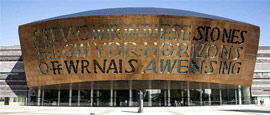Cardiff History
The Welsh capital might be one of Europe’s youngest but like neighbouring London, it has Roman roots. Battling to contain the rampant Silures, the Iron Age tribe that once inhabited the land, the Romans set up a wooden fort on the site of what is now Cardiff Castle.
Although the fort was abandoned when the Romans left, Cardiff wasn’t quite dead and it was revived for good when another invader, William the Conqueror, arrived. William rebuilt the fort in 1081, this time in stone, and as a result, the city began to put down roots.
However, it was not all plain sailing for the fledgling city. It suffered serious damage in 1401 when a rebellion against English rule, led by Owain Glyndŵr, saw much of Cardiff being destroyed. The damage was so bad that rebuilding didn’t begin until 1423. In the years that followed, Cardiff stagnated, becoming little more than a military backwater.
All that changed when Henry VIII took to the throne and passed the Laws in Wales Acts, which turned Cardiff the county town for Glamorganshire. In 1581, Elizabeth I granted the city its first royal charter. However, it was successive Marquesses of Bute who really transformed Cardiff, beginning with efforts to restore Cardiff Castle in 1793. Another Marquess, John Crichton-Stuart, dedicated his life to building the Cardiff docks.
As the demand for coal grew, so did the population of the city, and Cardiff became the biggest town in Wales by 1881. Its first university, the University College South Wales and Monmouthshire, went up in 1893 and by 1905 Cardiff was granted city status.
Modern day Cardiff was built on the profits of mining. A Victorian boom town, it exported coal and steel from the Welsh hills all over the world. At its peak, Cardiff became the biggest coal port in the world with more than 13 million tonnes of the black stuff being exported from the city by 1913.
Today, thanks to an urban regeneration programme, Cardiff is back to its bustling best and boasts modern shopping centres, world class galleries and a shiny sports arena.
Did you know?
• Opened in 1894, Spillers in Cardiff is the oldest record shop in the world.
• Children’s author Roald Dahl was born in Cardiff in 1916.
• The 11th century Cardiff Castle was used as an air raid shelter during WWII.
Do you have any Feedback about this page?
© 2025 Columbus Travel Media Ltd. All rights reserved. No part of this site may be reproduced without our written permission, click here for information on Columbus Content Solutions.




 You know where
You know where